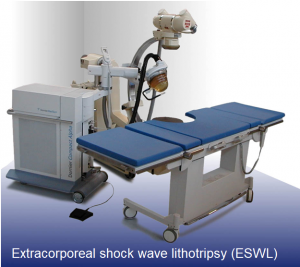Management of urinary stones in new millenium
What is the ESWL procedure?
Extracorporeal shock wave lithotripsy (ESWL) uses shock waves to break a kidney stone into small pieces that can more easily travel through the urinary tract and pass from the body. See a picture of ESWL. You lie on a water-filled cushion, and the surgeon uses X-rays or ultrasound tests to precisely locate the stone.
Is ESWL treatment painful?
After treatment, you will have blood in your urine and possibly abdominal pain or aching for several days. Other people experience severe cramping pain as shattered stone fragments make their way out of the body. Oral pain medication and drinking lots of water will help relieve symptoms.

Advantages
- Success rate (95%)
- No admission
- Non-Invasive
- No Anaesthesia
- Age no bar
- Minimal side effects
Disadvantages
- May require no. of Sittings
- A stent may be require
- Size limitations of 2.5 to 3 cm
- Hard stones
- Anesthesia required in children
- Steinstrasse, post-op pain

